Recommender Systems
Linyuan L¨ua,b,c, Mat´uˇs Medob, Chi Ho Yeungb,d, Yi-Cheng Zhanga,b,c,∗, Zi-Ke Zhanga,b,c,
Tao Zhoua,b,c,e
aInstitute of Information Economy, Hangzhou Normal University, Hangzhou, 310036, PR China
bDepartment of Physics, University of Fribourg, Fribourg, CH-1700, Switzerland
cWeb Sciences Center, University of Electronic Science and Technology of China, Chengdu, 610054, PR
dThe Nonlinearity and Complexity Research Group, Aston University, Birmingham B4 7ET, United
eBeijing Computational Science Research Center, Beijing, 100084, PR China
Kingdom
China
Abstract
The ongoing rapid expansion of the Internet greatly increases the necessity of effective
recommender systems for filtering the abundant information. Extensive research for rec-
ommender systems is conducted by a broad range of communities including social and
computer scientists, physicists, and interdisciplinary researchers. Despite substantial theo-
retical and practical achievements, unification and comparison of different approaches are
lacking, which impedes further advances. In this article, we review recent developments in
recommender systems and discuss the major challenges. We compare and evaluate available
algorithms and examine their roles in the future developments. In addition to algorithms,
physical aspects are described to illustrate macroscopic behavior of recommender systems.
Potential impacts and future directions are discussed. We emphasize that recommendation
has a great scientific depth and combines diverse research fields which makes it of interests
for physicists as well as interdisciplinary researchers.
Keywords:
recommender systems, information filtering, networks
2
1
0
2
b
e
F
6
]
h
p
-
c
o
s
.
s
c
i
s
y
h
p
[
1
v
2
1
1
1
.
2
0
2
1
:
v
i
X
r
a
∗Corresponding author
Email address: yi-cheng.zhang@unifr.ch (Yi-Cheng Zhang)
Preprint submitted to Physics Reports
February 7, 2012
�
Contents
1 Introduction
2 Real Applications of Recommender Systems
2.1 Netflix Prize . . . . . . . . . . . . . . . . . . . . . . . . . . . . . . . . . . .
. . . . . . . . . . . . . . . . . . . . . . . . . . . . . . . .
2.2 Major challenges
3 Definitions of Subjects and Problems
3.1 Networks . . . . . . . . . . . . . . . . . . . . . . . . . . . . . . . . . . . . .
3.2 Bipartite Networks and Hypergraphs . . . . . . . . . . . . . . . . . . . . .
3.3 Recommender Systems . . . . . . . . . . . . . . . . . . . . . . . . . . . . .
3.4 Evaluation Metrics for Recommendation . . . . . . . . . . . . . . . . . . .
3.4.1 Accuracy Metrics . . . . . . . . . . . . . . . . . . . . . . . . . . . .
3.4.2 Rank-weighted Indexes . . . . . . . . . . . . . . . . . . . . . . . . .
3.4.3 Diversity and Novelty . . . . . . . . . . . . . . . . . . . . . . . . . .
3.4.4 Coverage . . . . . . . . . . . . . . . . . . . . . . . . . . . . . . . . .
4 Similarity-based methods
4.1 Algorithms . . . . . . . . . . . . . . . . . . . . . . . . . . . . . . . . . . . .
4.1.1 User similarity . . . . . . . . . . . . . . . . . . . . . . . . . . . . .
Item similarity . . . . . . . . . . . . . . . . . . . . . . . . . . . . .
4.1.2
4.1.3
Slope One predictor . . . . . . . . . . . . . . . . . . . . . . . . . . .
4.2 How to define similarity . . . . . . . . . . . . . . . . . . . . . . . . . . . .
4.2.1 Rating-based similarity . . . . . . . . . . . . . . . . . . . . . . . . .
Structural similarity . . . . . . . . . . . . . . . . . . . . . . . . . .
4.2.2
4.2.3
Similarity involving external information . . . . . . . . . . . . . . .
5 Dimensionality Reduction Techniques
5.1 Singular Value Decomposition (SVD) . . . . . . . . . . . . . . . . . . . . .
5.2 Bayesian Clustering . . . . . . . . . . . . . . . . . . . . . . . . . . . . . . .
5.3 Probabilistic Latent Semantic Analysis (pLSA) . . . . . . . . . . . . . . . .
5.4 Latent Dirichlet Allocation (LDA) . . . . . . . . . . . . . . . . . . . . . . .
6 Diffusion-based methods
6.1 Heat diffusion algorithm (HDiff) . . . . . . . . . . . . . . . . . . . . . . . .
6.2 Multilevel spreading algorithm (MultiS)
. . . . . . . . . . . . . . . . . . .
6.3 Probabilistic spreading algorithm (ProbS)
. . . . . . . . . . . . . . . . . .
6.4 Hybrid spreading-relevant algorithms . . . . . . . . . . . . . . . . . . . . .
7 Social filtering
7.1 Social Influences on Recommendations
. . . . . . . . . . . . . . . . . . . .
7.2 Trust-Aware Recommender Algorithms . . . . . . . . . . . . . . . . . . . .
7.3 Adaptive Social Recommendation Models . . . . . . . . . . . . . . . . . . .
2
2
3
4
6
8
8
10
13
15
16
18
19
21
21
21
23
24
24
26
26
27
31
33
33
37
39
41
44
44
45
46
49
52
52
54
55
�
8 Meta approaches
8.1 Tag-aware methods . . . . . . . . . . . . . . . . . . . . . . . . . . . . . . .
8.2 Time-aware methods . . . . . . . . . . . . . . . . . . . . . . . . . . . . . .
8.3
Iterative refinement . . . . . . . . . . . . . . . . . . . . . . . . . . . . . . .
8.4 Hybrid algorithms . . . . . . . . . . . . . . . . . . . . . . . . . . . . . . . .
9 Performance evaluation
10 Outlook
References
58
58
59
61
63
65
69
72
1
�
1. Introduction
Thanks to computers and computer networks, our society is undergoing rapid transfor-
mation in almost all aspects. We buy online, gather information by search engines and live
a significant part of our social life on the Internet. The fact that many of our actions and
interactions are nowadays stored electronically gives researchers the opportunity to study
socio-economical and techno-social systems at much better level of detail. Traditional “soft
sciences”, such as sociology or economics, have their fast-growing branches relying on the
study of these newly available massive data sets [1, 2]. Physicists, with their long experi-
ence with data-driven research, have joined this trend and contributed to many fields such
as finance [3, 4], network theory [5, 6, 7, 8, 9] and social dynamics [10] which are outside
their traditional realm. The study of recommender systems and information filtering in
general is no exception with the interest of physicists steadily increasing over the past
decade. The task of recommender systems is to turn data on users and their preferences
into predictions of users’ possible future likes and interests. The study of recommender
systems is at crossroads of science and socio-economic life and its huge potential was first
noticed by web entrepreneurs in the forefront of the information revolution. While being
originally a field dominated by computer scientists, recommendation calls for contributions
from various directions and is now a topic of interest also for mathematicians, physicists,
and psychologists. For instance, it is not a coincidence that an approach based on what
psychologists know about human behavior scored high in a recent recommendation contest
organized by the commercial company Netflix [11].
When computing recommendations for a particular user, the very basic approach is
to select the objects favored by other users that are similar to the target user. Even
this simple approach can be realized in a multitude of ways—this is because the field of
recommendation lacks general “first principles” from which one could deduce the right way
to recommend. For example, how best to measure user similarity and assess its uncertainty?
How to aggregate divergent opinions from various users? How to handle users for whom
little information is available? Should all data be trusted equally or can one detect reckless
or intentionally misleading opinions? These and similar issues arise also when methods
more sophisticated than those based on user similarity are used. Fortunately, there exist
a number of real data sets that can be used to measure and compare performance of
individual methods. In consequence, similarly to physics, it is the experiment what decides
which recommendation approach is good and which is not.
It would be very misleading to think that recommender systems are studied only because
suitable data sets are available. While the availability of data is important for empirical
evaluation of recommendation methods, the main driving force comes from practice: elec-
tronic systems give us too much choice to handle by ourselves. The interest from industry
is hardly surprising—an early book on the nascent field of recommendation, Net Worth by
John Hagel III and Marc Singer [12], clearly pointed out the enormous economic impact of
“info-mediaries” who can greatly enhance individual consumers’ information capabilities.
Most e-commerce web sites now offer various forms of recommendation—ranging from sim-
ply showing the most popular items or suggesting other products by the same producer to
2
�
complicated data mining techniques. People soon realized that there is no unique best rec-
ommendation method. Rather, depending on the context and density of the available data,
different methods adapting to particular applications are most likely to succeed. Hence
there is no panacea, and the best one can do is to understand the underlying premises and
recommender mechanisms, then one can tackle many diverse application problems from
the real life examples. This is also reflected in this review where we do not try to highlight
any ultimate approach to recommendation. Instead, we review the basic ideas, methods
and tools with particular emphasis on physics-rooted approaches.
The motivation for writing this review is multifold. Firstly, while extensive reviews
of recommender systems by computer scientists already exists [13, 14, 15], the view of
physicists is different from that of computer scientists by using more the complex networks
approach and adapting various classical physics processes (such as diffusion) for information
filtering. We thus believe that this review with its structure and emphasis on respective
topics can provide a novel point of view. Secondly, the past decade has already seen a
growing interest of physicists in recommender systems and we hope that this review can
be a useful source for them by describing the state of the art in language which is more
familiar to the physics community. Finally, the interdisciplinary approach presented here
might provide new insights and solutions for open problems and challenges in the active
field of information filtering.
This review is organized as follows. To better motivate the problem, In Section 2 we
begin with a discussion of real applications of recommender systems. Next, in Section 3 we
introduce basic concepts—such as complex networks, recommender systems, and metrics
for their evaluation—that form a basis for all subsequent exposition. Then we proceed to
description of recommendation algorithms where traditional approaches (similarity-based
methods in Section 4 and dimensionality reduction techniques in Section 5) are followed by
network-based approaches which have their origin in the random walk process well known
to all physicists (in Section 6). Methods based on external information, such as social
relationships (in Section 7), keywords or time stamps (in Section 8), are also included. We
conclude with a brief evaluation of methods’ performance in Section 9 and a discussion on
the outlook of the field in Section 10.
2. Real Applications of Recommender Systems
Thanks to the ever-decreasing costs of data storage and processing, recommender sys-
tems gradually spread to most areas of our lives. Sellers carefully watch our purchases to
recommend us other goods and enhance their sales, social web sites analyze our contacts
to help us connect with new friends and get hooked with the site, and online radio stations
remember skipped songs to serve us better in the future (see more examples in Table 1).
In general, whenever there is plenty of diverse products and customers are not alike, per-
sonalized recommendation may help to deliver the right content to the right person. This
is particularly the case for those Internet-based companies that try to make use of the
so-called long-tail [16] of goods which are rarely purchased yet due to their multitude they
can yield considerable profits (sometimes they are referred to as “worst-sellers”). For ex-
3
�
ample on Amazon, between 20 to 40 percent of sales is due to products that do not belong
to the shop’s 100 000 most saled products [17]. A recommender system may hence have
significant impact on a company’s revenues: for example, 60% of DVDs rented by Netflix
are selected based on personalized recommendations.1
As discussed in [18], recommender systems not only help decide which products to
offer to an individual customer, they also increase cross-sell by suggesting additional prod-
ucts to the customers and improve consumer loyalty because consumers tend to return to
the sites that best serve their needs (see [19] for an empirical analysis of the impact of
recommendations and consumer feedback on sales at Amazon.com).
Since no recommendation method serves best all customers, major sites are usually
equipped with several distinct recommendation techniques ranging from simple popularity-
based recommendations to sophisticated techniques many of which we shall encounter in
the following sections. Further, new companies emerge (see, for example, string.com)
which aim at collecting all sorts of user behavior (ranging from pages visited on the web
and music listened on a personal player to “liking” or purchasing items) and using it to
provide personalized recommendations of different goods or services.
2.1. Netflix Prize
In October 2006, the online DVD rental company Netflix released a dataset containing
approximately 100 million anonymous movie ratings and challenged researchers and prac-
titioners to develop recommender systems that could beat the accuracy of the company’s
recommendation system, Cinematch [20]. Atlhough the released data set represented only
a small fraction of the company’s rating data, thanks to its size and quality it fast became
a standard in the data mining and machine learning community. The data set contained
ratings in the integer scale from 1 to 5 which were accompanied by dates. For each movie,
title and year of release were provided. No information about users was given. Submitted
predictions were evaluated by their root mean squared error (RMSE) on a qualifying data
set containing over 2,817,131 unknown ratings. Out of 20,000 registered teams, 2,000 teams
submitted at least one answer set. On 21 September 2009, the grand prize of $1,000,000
was awarded to a team that overperformed the Cinematch’s accuracy by 10%. At the
time when the contest was closed, there were two teams that achieved the same precision.
The prize was awarded to the team that submitted their results 20 minutes earlier than
the other one. (See [11] for a popular account on how the participants struggled with the
challenge.)
There are several lessons that we have learned in this competition [21]. Firstly, the
company gained publicity and a superior recommendation system that is supposed to
improve user satisfaction. Secondly, ensemble methods showed their potential of improving
accuracy of the predictions.2 Thirdly, we saw that accuracy improvements are increasingly
1As presented by Jon Sanders (Recommendation Systems Engineering, Netflix) during the talk “Re-
search Challenges in Recommenders” at the 3rd ACM Conference on Recommender Systems (2009).
2The ensemble methods deal with the selection and organization of many individual algorithms to
achieve better prediction accuracy. In fact, the winning team, called BellKor’s Pragmatic Chaos, was a
4
�
Site
Amazon
Facebook
WeFollow
MovieLens
Nanocrowd
Jinni
Findory
Digg
Zite
Meehive
Netflix
CDNOW
eHarmony
Chemistry
True.com
Perfectmatch
CareerBuilder
Monster
Pandora
Mufin
StumbleUpon web sites
What is recommended
books/other products
friends
friends
movies
movies
movies
news
news
news
news
DVDs
CDs/DVDs
dates
dates
dates
dates
jobs
jobs
music
music
Table 1: Popular sites using recommender systems. Besides, there are also some companies de-
voting themselves to recommendation techniques, such as Baifendian (www.baifendian.com), Baynote
(www.baynote.com), ChoiceStream (www.choicestream.com), Goodrec (www.goodrec.com), and others.
5
�
demanding when RMSE drops below a certain level. Finally, despite the company’s effort,
anonymity of its users was not sufficiently ensured [25]. As a result, Netflix was sued by
one of its users and decided to cancel a planned second competition.
2.2. Major challenges
Researchers in the field of recommender systems face several challenges which pose
danger for the use and performance of their algorithms. Here we mention only the major
ones:
1. Data sparsity. Since the pool of available items is often exceedingly large (major on-
line bookstores offer several millions of books, for example), overlap between two users
is often very small or none. Further, even when the average number of evaluations
per user/item are high, they are distributed among the users/items very unevenly
(usually they follow a power-law distribution [26]) and hence majority of users/items
may have expressed/received only a few ratings. Hence, an effective recommender
algorithm must take the data sparsity into account [27].
2. Scalability. While the data is mostly sparse, for major sites it includes millions of
users and items. It is therefore essential to consider the computational cost issues
and search for recommender algorithms that are either little demanding or easy to
parallelize (or both). Another possible solution is based on using incremental versions
of the algorithms where, as the data grows, recommendations are not recomputed
globally (using the whole data) but incrementally (by slightly adjusting previous
recommendations according to the newly arrived data) [28, 29]. This incremental
approach is similar to perturbation techniques that are widely used in physics and
mathematics [30].
3. Cold start. When new users enter the system, there is usually insufficient information
to produce recommendation for them. The usual solutions of this problem are based
on using hybrid recommender techniques (see Section 8.4) combining content and
collaborative data [31, 32] and sometimes they are accompanied by asking for some
base information (such as age, location and preferred genres) from the users. Another
way is to identify individual users in different web services. For example, Baifendian
developped a technique that could track individual users’ activities in several e-
commerce sites, so that for a cold-start user in site A, we could make recommendation
according to her records in sites B, C, D, etc.
4. Diversity vs. accuracy. When the task is to recommend items which are likely to be
appreciated by a particular user, it is usually most effective to recommend popular
and highly rated items. Such recommendation, however, has very little value for the
users because popular objects are easy to find (often they are even hard to avoid)
without a recommender system. A good list of recommended items hence should
combined team of BellKor [22], Pragmatic Theory [23] and BigChaos [24] (of course, it was not a simple
combination but a sophisticated design), and each of them consists of many individual algorithms. For
example, the Pragmatic Theory solution considered 453 individual algorithms.
6
�
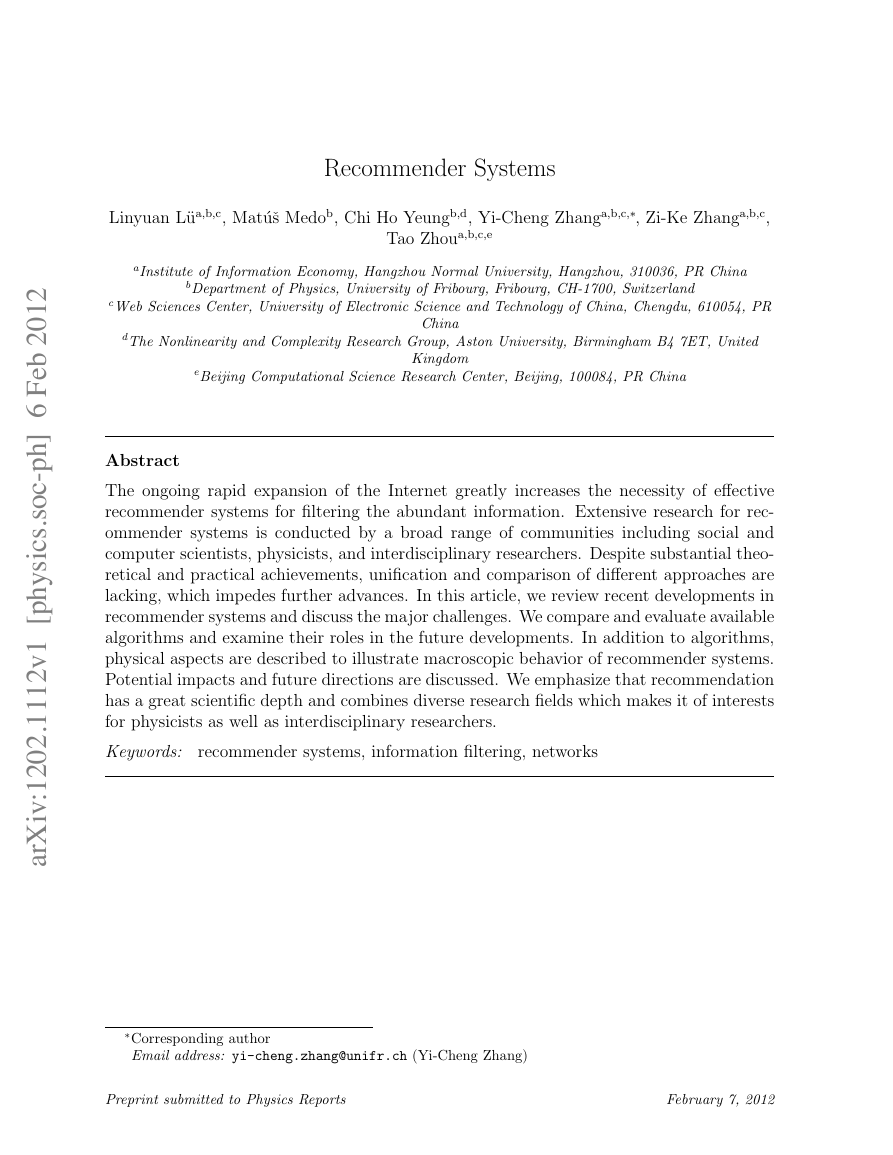
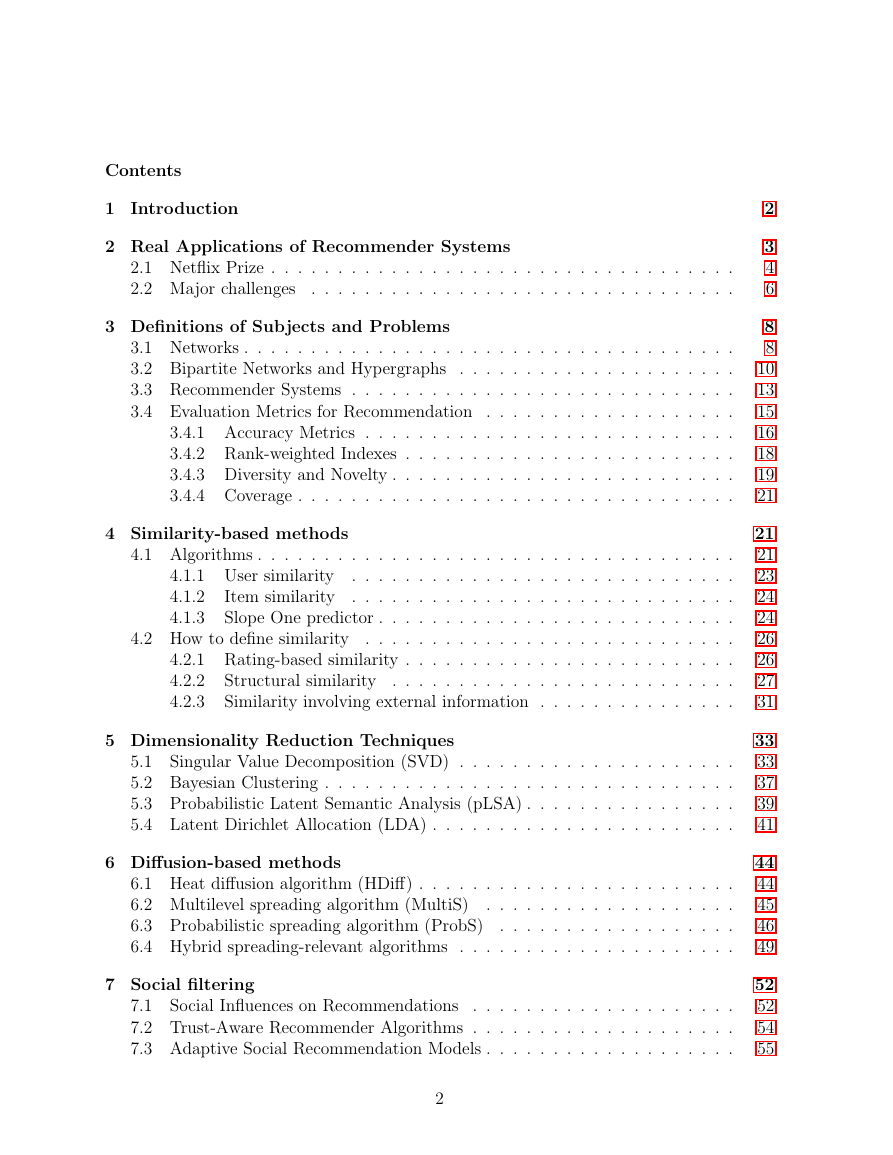
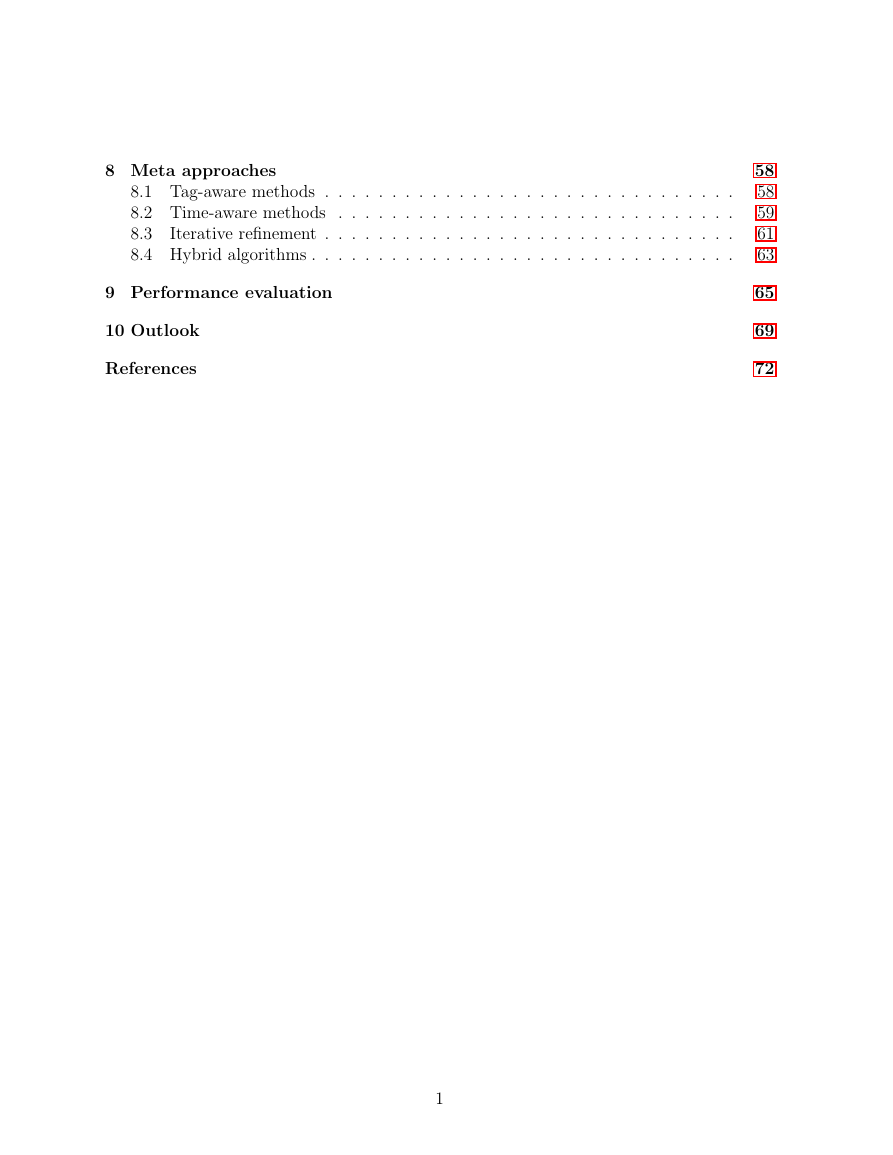
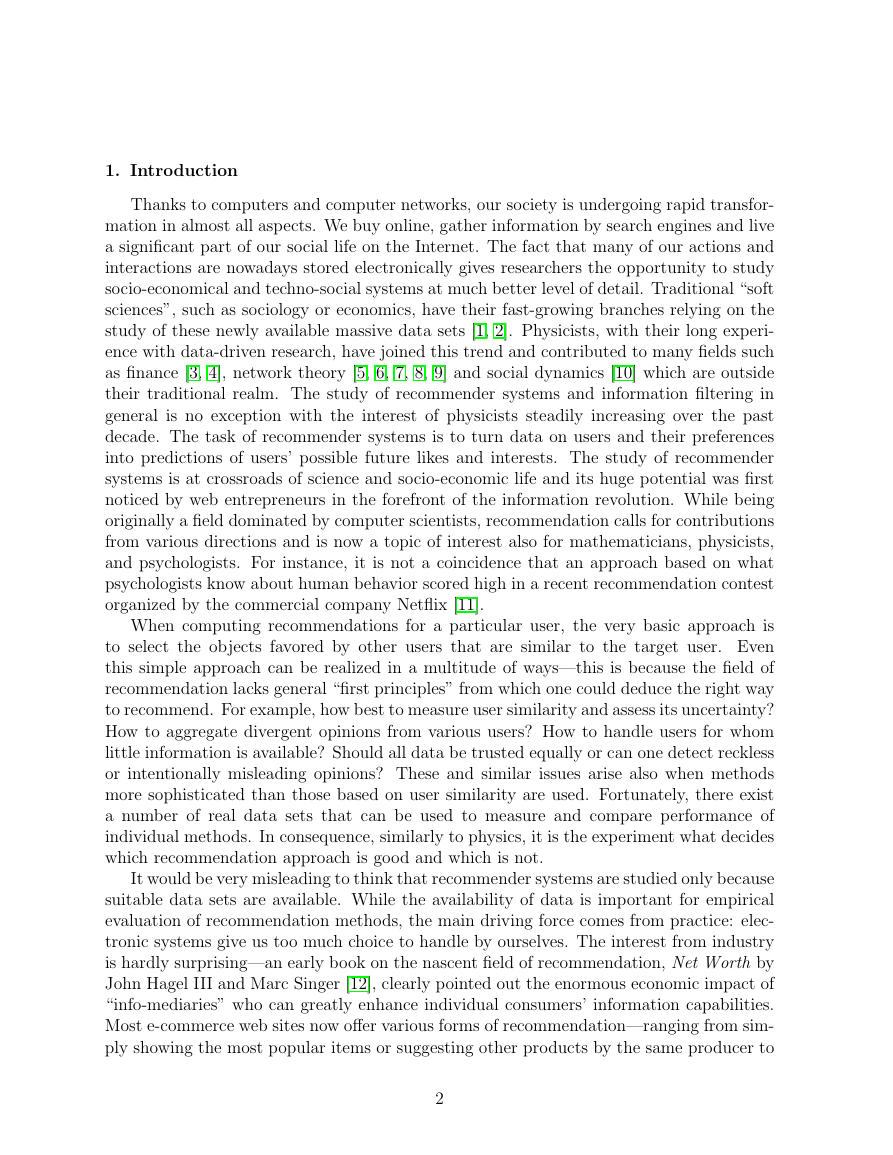
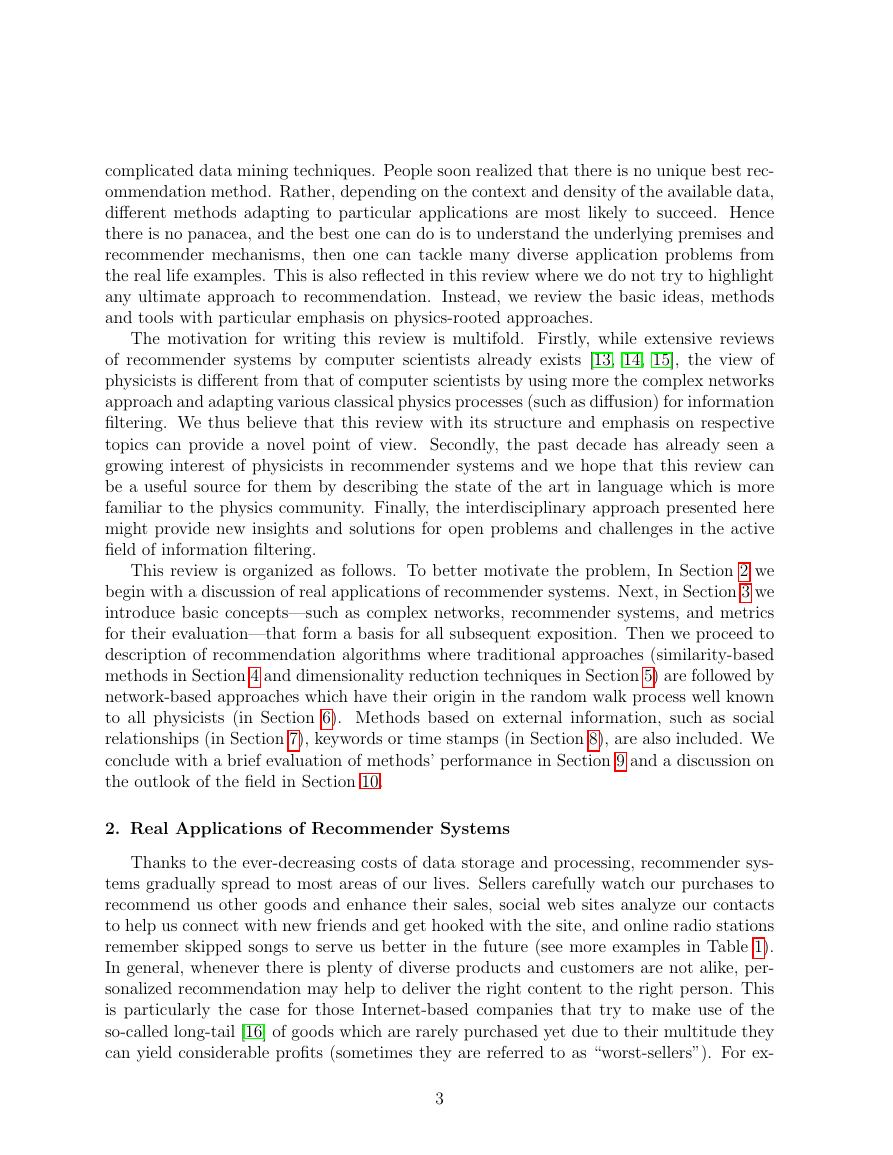

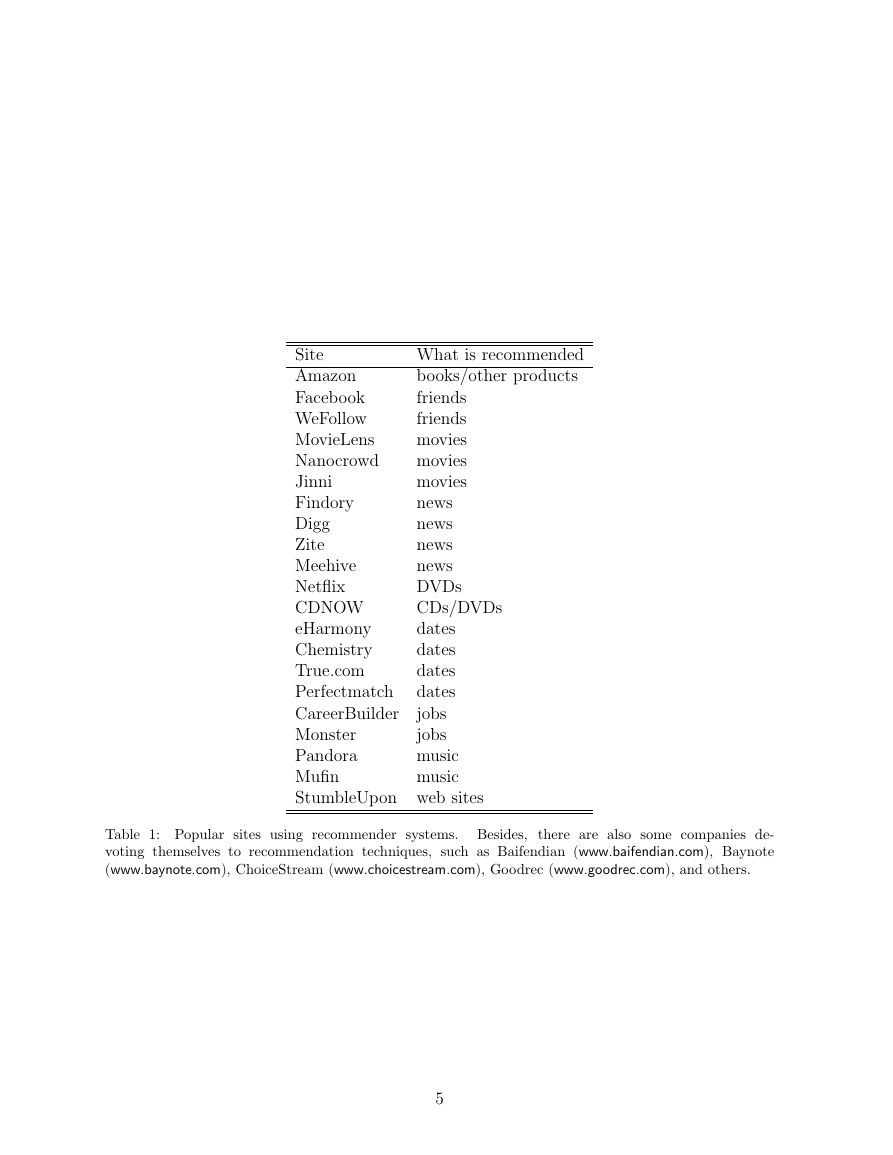
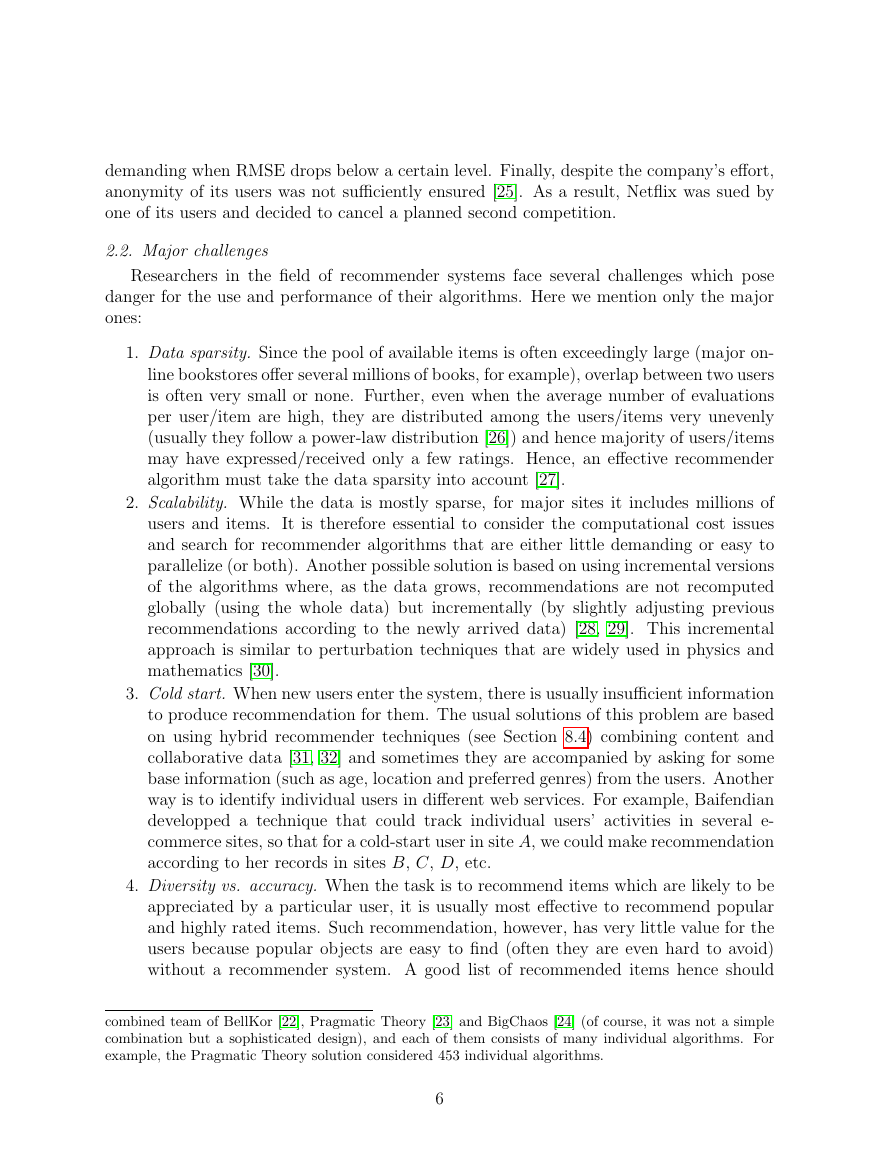








 2023年江西萍乡中考道德与法治真题及答案.doc
2023年江西萍乡中考道德与法治真题及答案.doc 2012年重庆南川中考生物真题及答案.doc
2012年重庆南川中考生物真题及答案.doc 2013年江西师范大学地理学综合及文艺理论基础考研真题.doc
2013年江西师范大学地理学综合及文艺理论基础考研真题.doc 2020年四川甘孜小升初语文真题及答案I卷.doc
2020年四川甘孜小升初语文真题及答案I卷.doc 2020年注册岩土工程师专业基础考试真题及答案.doc
2020年注册岩土工程师专业基础考试真题及答案.doc 2023-2024学年福建省厦门市九年级上学期数学月考试题及答案.doc
2023-2024学年福建省厦门市九年级上学期数学月考试题及答案.doc 2021-2022学年辽宁省沈阳市大东区九年级上学期语文期末试题及答案.doc
2021-2022学年辽宁省沈阳市大东区九年级上学期语文期末试题及答案.doc 2022-2023学年北京东城区初三第一学期物理期末试卷及答案.doc
2022-2023学年北京东城区初三第一学期物理期末试卷及答案.doc 2018上半年江西教师资格初中地理学科知识与教学能力真题及答案.doc
2018上半年江西教师资格初中地理学科知识与教学能力真题及答案.doc 2012年河北国家公务员申论考试真题及答案-省级.doc
2012年河北国家公务员申论考试真题及答案-省级.doc 2020-2021学年江苏省扬州市江都区邵樊片九年级上学期数学第一次质量检测试题及答案.doc
2020-2021学年江苏省扬州市江都区邵樊片九年级上学期数学第一次质量检测试题及答案.doc 2022下半年黑龙江教师资格证中学综合素质真题及答案.doc
2022下半年黑龙江教师资格证中学综合素质真题及答案.doc